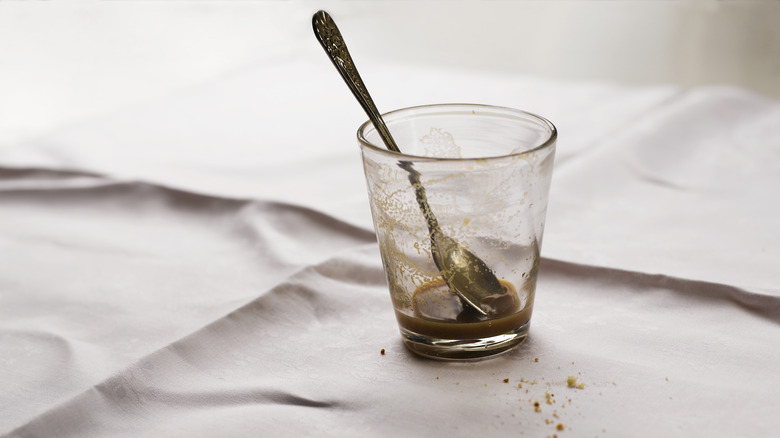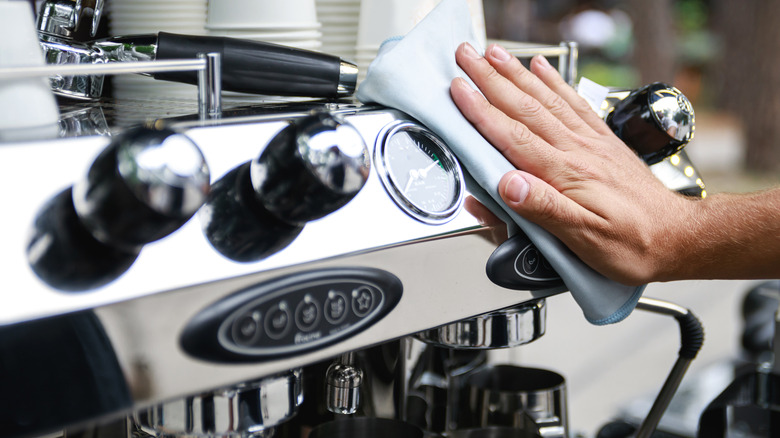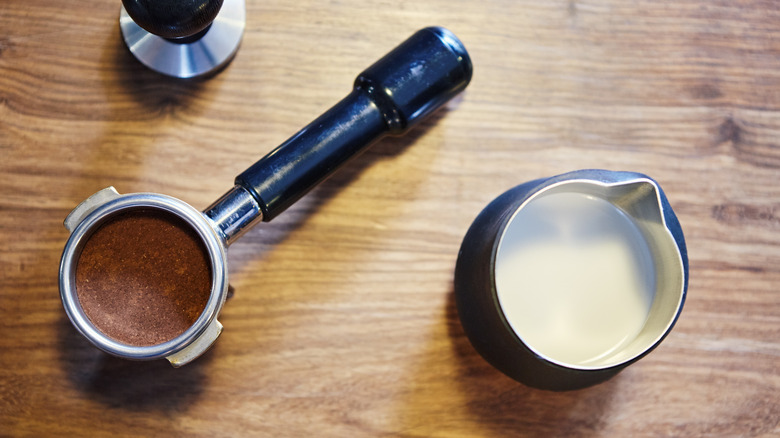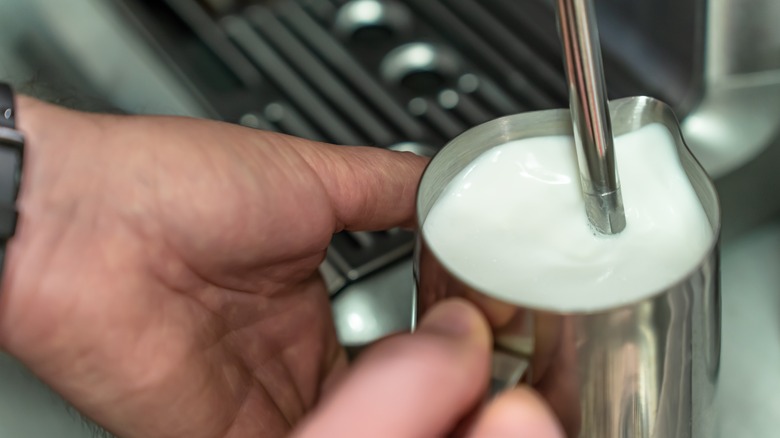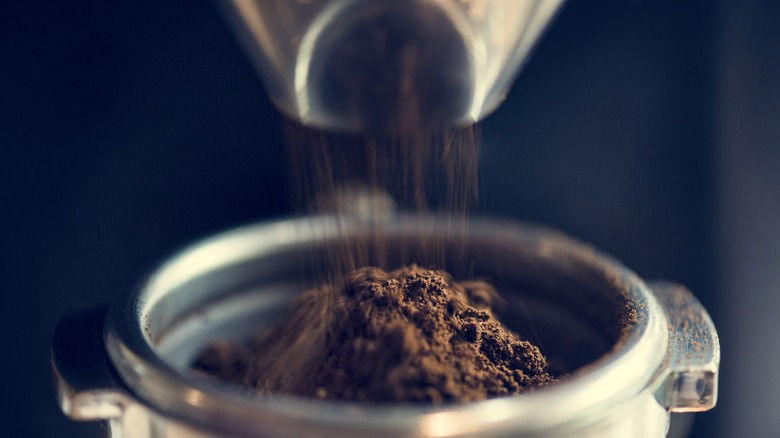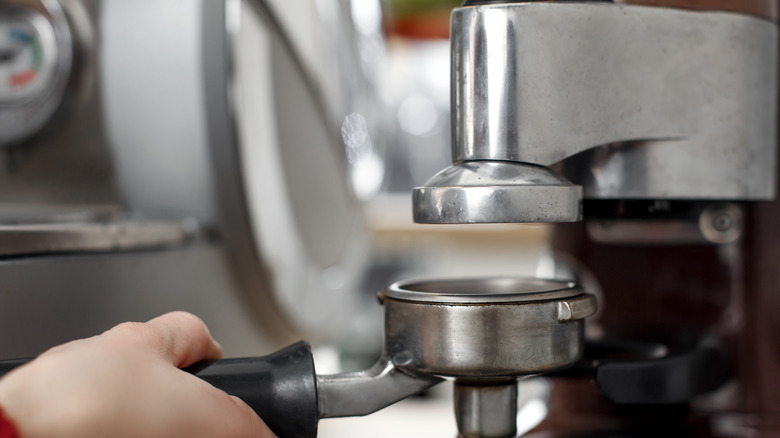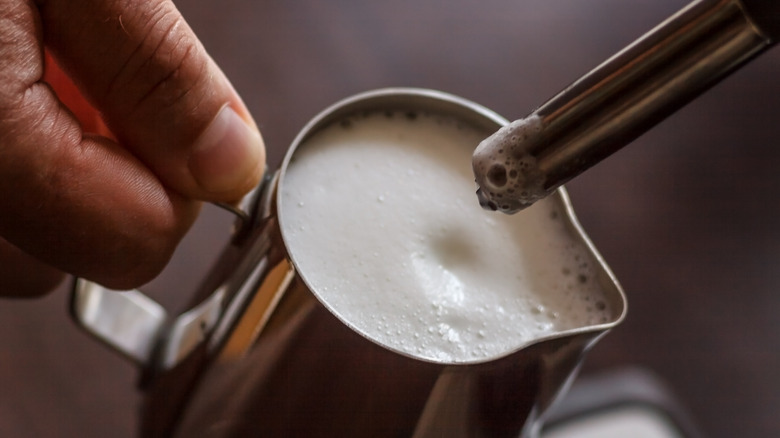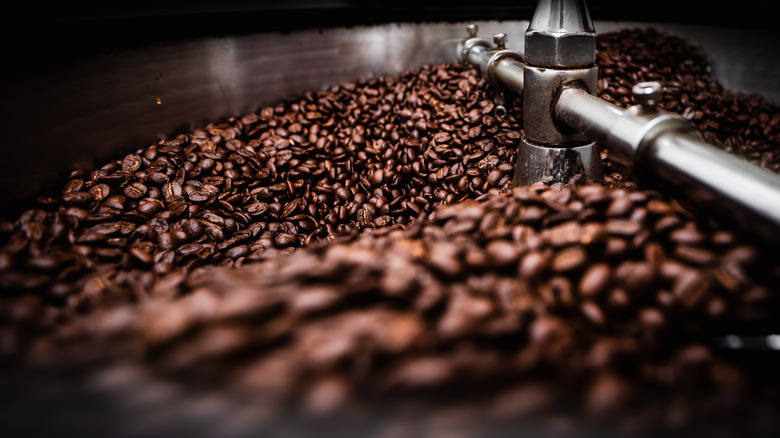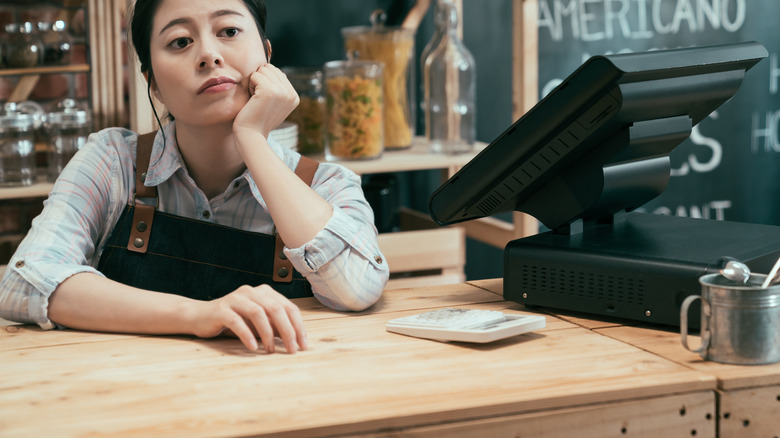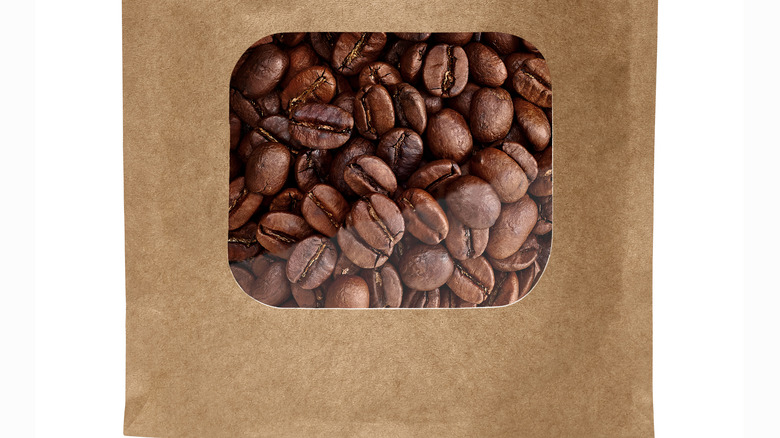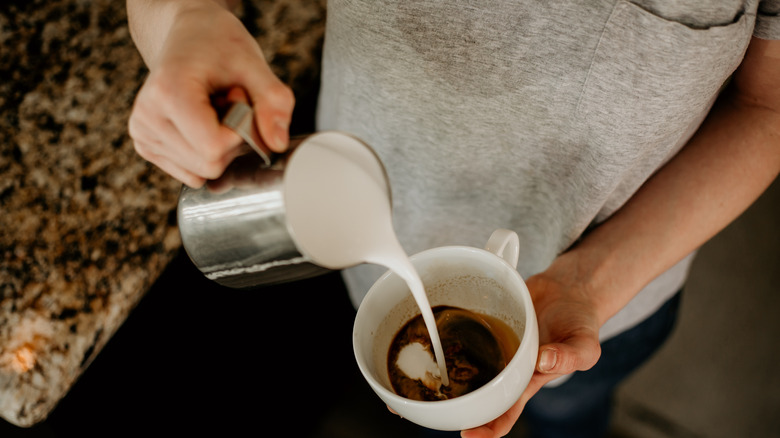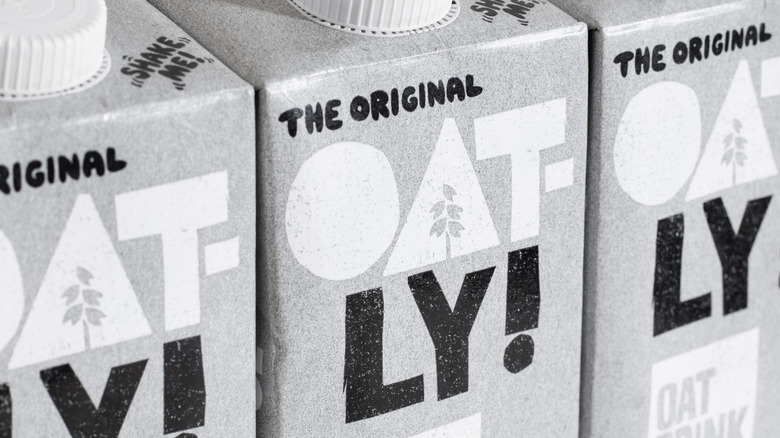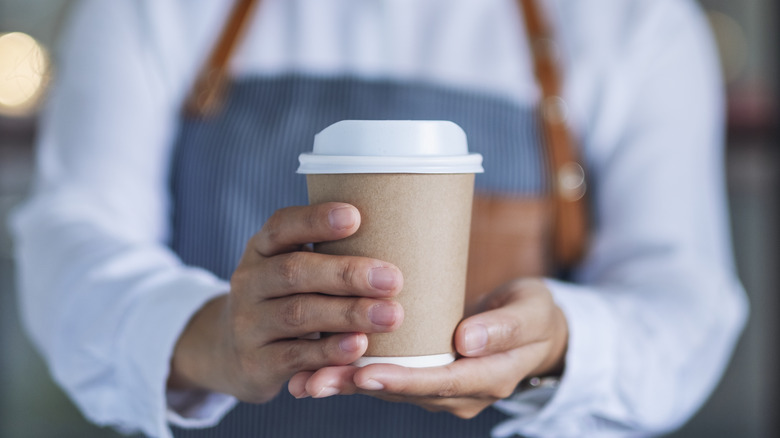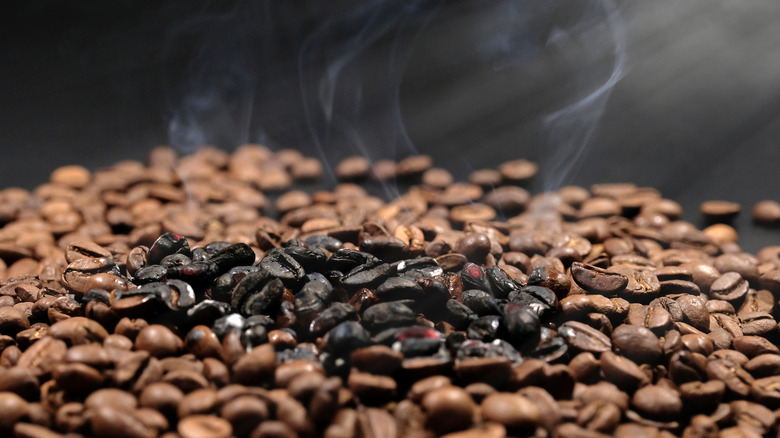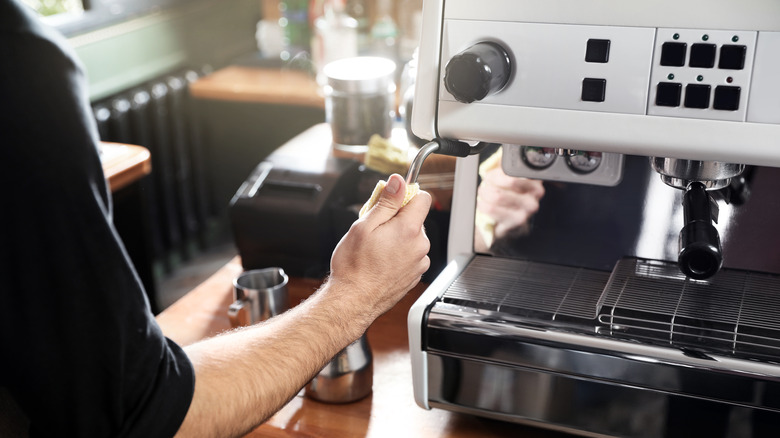20 Red Flags At A Café That Could Indicate A Bad Cup Of Coffee
One of the best ways to romanticize your life is to go to a café alone, grab your favorite cappuccino, and pick a comfy chair to catch up on work or studying. And while we all have our favorite cafés in town, there always comes a time to try something new — in search of a better cup of coffee or a productive, cozy atmosphere.
You may consult apps like Yelp or simply by asking your friends where the best coffee place is in town. Once you have done your research, made your decision, and walked through the doors of what might be your new go-to café — you should rest assured that your work isn't done yet. You'll still have to do some sleuthing to see if your café choice is truly the best. After all, who wants to pay $6 for a mediocre latte? Here are some of the biggest red flags at a café, coffee shop, or similar establishment that may indicate your coffee will be lackluster.
Dirty glassware or tableware
One sign of a bad café experience is dirty tableware or glassware. This red flag is mostly tailored to cafés offering sit-down service where patrons can choose to take out or eat-in. If you order a pastry and the café and your plate have residue of something other than that pastry, you may wonder about the cleanliness of the café and the employees' attention to detail. So while the dishwasher should clean all the coffee residue off the cup and particles off the plates, the employees should be attentive to not letting dirty glassware and tableware slip out onto the café floor. If you're worried about the cleanliness of your tableware, we recommend ordering a to-go coffee — or the more eco-friendly version of bringing your own mug.
A full, dirty hopper on the grinder
If you're ordering coffee from a café, you should expect to get the freshest cup of coffee you can. If you notice hoppers (which sit on top of the coffee grinder) are full-to-the-brim with beans, you might wonder how fresh the beans in the hopper are. A good café will cycle through the beans to ensure customers are getting the freshest cup each time.
Another red flag related to the hopper is its cleanliness. Is there a visible, opaque residue on the inside of the hopper, or is it clear? Your shot of espresso may taste off if the hopper — which in turn causes the residue to form on the inside of the hopper (via Perfect Daily Brew). A good café is on top of cleaning its bean hoppers to ensure the freshest flavors in each cup.
Dirty wiping cloths on the counter
Have you ever cleaned your entire kitchen with the same cloth? Depending on how dirty your kitchen is, using the same cloth may mean schmearing coffee grounds, toast crumbs, and splashing tomato sauce onto other surfaces. The same principle applies to cafés; the cleaning rags should be shuffled and regularly cleaned to ensure that the surfaces in the café are pristine.
If you notice the café has dirty cleaning rags lying around, you should question if your coffee will be safe to drink. Per Cleanipedia, salmonella bacteria can last up to four hours on some surfaces but have been shown to last up to 50 days on dirty surfaces. The common cold can last on surfaces and make people sick for one whole day.
A messy condiment station
We know what happens when people have granulated sugar, sticky honey, and coffee filled to the brim of travel cups — spills, spills, spills! A messy condiment station is one sign that café staff may not be able to keep up with the pace of the coffee shop — and that's a red flag. According to Perfect Daily Grind, the COVID-19 pandemic allowed many restaurants, including cafés, to reevaluate how they perform regular cleaning maintenance in their businesses. The website notes that café staff should clean commonly touched surfaces at regular thirty-minute intervals during service — and ideally more during busy hours.
As a customer, we can all do our parts to keep the condiment station clean. If you spill something, always let the staff know so it can be cleaned up quickly.
Milk left on the counter or condiment station for too long
One of the biggest biological hazards in a café is the risk of consuming spoiled dairy products. During a busy service, milk being left out on the barista's counter or the condiment station at room temperature can increase the risk of foodborne illnesses. According to U.S. Dairy, dairy products should not be left out of the cooler or refrigerator for more than two hours at a time. The milk should be kept in the coldest part of the refrigerator — not on the door where dramatic fluctuations in temperature may cause more rapid degradation of the milk. A safe café will have its milk products on the coffee bar stored in insulated canisters to prevent spoilage.
A steam wand caked in milk
The steam wand is a key part of any barista's toolbox because it is used to make steamed milk beverages like lattes and cappuccinos. Genius Equipment notes that failing to clean your steam wand can result in clogs and grime in the machine as a result of the milk proteins building up. Moreover, when the milk is steamed, the tiny fat particles can congeal around the wand. In turn, this can lower the quality of steam and create pressure buildup that damages the internal functions of the machine.
If you notice caked or gunky steam wands on the espresso machines, you should stick to ordering a different beverage — like an Americano, drip coffee, or iced latte — from the café. It's better to be safe than sorry.
Cafés that don't grind their own coffee
Any coffee enthusiast knows how important the right grind is on a cup of coffee. Different types of grounds, like a coarse ground on a drip coffee or a fine grind for espresso, are critical to distinguishing the types of coffee from one another. All baristas and cafés should grind their coffee in-house. Freshly-ground coffee has a more consistent flavor and quality than pre-ground coffee (via Knoxville Brew). When the coffee beans are ground, the beans have a greater surface area to release their aromatic qualities. If the café grinds its beans in-house, it reduces the amount of time that the oils and flavor have to be released — thus preserving it in every cup. If you aren't able to see a grinder in the café, you will likely be able to hear it.
Portafilters left on the head of the espresso machine
The portafilter is the metal holder for the ground espresso. After the grinds are tamped into the portafilter, the pressurized water passes through the puck to brew the espresso. But what happens to the puck after the barista is finished?
If the café service is busy, it is likely that the pucks are being removed from the machines very quickly to ensure that there is enough to accommodate new customers. But if the café is running slow, the baristas may forget about the puck and leave it in the machine until they need the machine again. Home Barista notes that the café should always remove the puck after brewing to prevent oil and material buildup in the machine that will impart bad flavors on the brew.
Poor steaming technique
Learning how to steam coffee is an act of precision and practice. And if you're paying for a coffee, you would expect that your barista has practiced enough to steam you the perfect beverage. According to Clive Coffee, you'll know your barista is using the proper steaming technique when you hear a slight hissing sound coming from the machine. A suctioning sound indicates the wand is too far submerged in the milk. A bubbling sound indicates the barista did not put the wand close enough to the surface.
If you hear a loud steam wand sound that sounds like screeching tires, there is not enough air being pushed into the milk. This can also mean the wand is not open enough or that your milk is being re-steamed, per Full Coffee Roast.
Untrained staff who are not versed in coffee vernacular
If you're curious about what kind of coffee you should order at a coffee shop, you should be able to ask about what kind of coffee a barista would recommend. Not being able to distinguish between the different types of coffee — like americanos, cortados, and macchiatos — tells you that the staff has very little knowledge of proper coffee vernacular. And why should you expect that the café can get the perfect beverage ratio if the staff can't explain the differences between its beverage offerings?
One example of a beverage commonly messed up at a café is a macchiato. According to Cru Kafe, a macchiato is a single shot of coffee with only a tablespoon or two of milk added. In comparison, a cortado has equal parts espresso to milk. If you're served either of these beverages in a latte-sized cup full of milk, you can be sure that what you're drinking isn't a true macchiato or cortado.
Absence of a roaster
It's hard to miss a coffee roasting machine at a café. If you want the freshest cup of coffee, you'll want to order from a café with an in-house roaster. The roasting process transforms the raw green cocoa beans into the aromatic, delectable beans that we coffee lovers enjoy (via The National Coffee Association USA). Once the coffee is roasted, it should be consumed as soon as the beans have off-gassed some of the carbon dioxide in the bean.
If your coffee roasts the beans in-house, it's a commitment to the freshness of every cup of coffee. The National Coffee Association notes that roasting is a very scientific process since heating the beans for too long can burn them while under-heating the beans may not create the ideal roast variety. A café having a roaster, in turn, is also a testament to the artisan practices (rather than the mass production of roasted beans).
Mistakes in the menu
When you go to a café, look at the website or the posted menu. If espresso is spelled "expresso" on the menu, little red flags should go up in your brain. Misspellings in the menu can indicate that this establishment doesn't take coffee seriously.
You can also tell a lot about a café by its website and menu look. If there are many options on the menu, it may indicate that the café is focusing on too many dishes rather than crafting excellent coffee — which is why you're there. FSR Magazine notes that a professional restaurant website will include things like clear food photography, contact information for reservations or customer concerns, and a concise menu.
Roasting dates that make you cringe
Many cafés sell whole beans for customers to take home and make their coffee with. If you ask politely, your barista may even grind those beans for you.
According to Clive Coffee, there is an important threshold that you should adhere to when it comes to purchasing whole-bean coffee. The peak flavor and freshness of whole beans is between four and 14 days of roasting. If you purchase beans that have immediately been roasted, these beans are still in the period of off-gassing carbon dioxide. Dark-roasted coffees will finish off-gassing within four days, while light-roast varieties may need between five and ten days to off-gas completely and develop those delicious aromatic notes. If coffee beans are sitting on the café shelf for more than two weeks, you're not getting the optimal flavor or aroma.
Not cleaning out the jug in between steaming
You deserve freshly steamed milk for your coffee every single time. If your barista is just refilling your milk jug rather than cleaning it out each time, you may get a strange flavor from your cup. When the milk is steamed, its chemical properties and proteins change. So instead of pouring out of the jug like cold milk, the steamed milk sticks to the sides of the jug and gets gunkier over time if the milk is recycled.
If you notice your barista re-using the same jug without cleaning it between customers, you can request that they use a fresh one. Many proper cafés have tools like jug rinsers to help quickly rinse the jugs to prevent buildup and keep the machines clean.
No equipment reserved for allergies
If you have an allergy or food intolerance, you know how stressful it can be to order food from any restaurant. Per the Perfect Daily Grind, preventing an allergic reaction is all about educating staff to examine labels for potential allergens (such as casein and whey as milk allergens). The café can also disclose information about allergens in its products on a menu so that folks know which foods to avoid. An allergen-friendly café will have color-coded labels for ingredients containing allergens, as well as a separate area and separate tools for preparing foods and drinks for individuals with allergies.
If you have an allergy or food intolerance, you should always ask what kind of measures the café takes to reduce contamination and allergens before ordering.
Baristas that put their fingers on the lip of a cup
There are right and wrong ways to hold a cup of coffee. Your barista should always hold the cup at a 4 o-clock angle to ensure that hands never make contact with the rim of the cup. If your barista touches the top of the cup, you open up opportunities for cross-contamination. Yuck!
Another contested issue in the espresso world is what side to place the mugs on to warm them. Many espresso machines have cup warmers on the top of the machine to help keep the cups warm between pulling shots. If there's no plastic or rubber grill between the machine and the cup, it can burn the drinker's lips. As long as there is a barrier between the cup and the warmer, the barista should place the cups upside down. Placing the cup upside down also limits the opportunity for the barista to touch the rim of the mug (via Eureka).
Rude staff
One of the big red flags at any bad restaurant is poor service. Poor service can look like several different things — an inattentive staff, poor manners or concern for customers, and overall mistakes that diminish the customer experience in the restaurant. The larger causes of poor staff behavior might reflect poor management, operating procedures, or an overall dysfunctional environment.
When it comes to cafés, you should always keep an eye out for apathy among staff. If you ask for a napkin, are you greeted with a smile or a "what now" attitude? The latter is apathy, and the former is an overall concern for customer satisfaction. And although busy periods in the café can always spark some stressful glares, the café staff should always express even-temperedness and concern for customer well-being.
Not making fresh espresso for iced lattes
An iced latte is a classic beverage on the coffee shop menu made with espresso, cold milk, and ice. Brewed espresso loses its flavor and aromatic qualities within a day after brewing, per Lux Haus. Once you pass that one-day mark, your espresso will lose its characteristic crema. The crema comes from the oils in the espresso rising to the surface, which in turn settle back into the coffee and cause unpleasant, bitter flavors to emerge.
While it would be easier for a café to make its cold espresso in advance and store the shots in the fridge for whenever it's time to make the iced latte — it comes at the cost of customer satisfaction. You'll want to be sure your café is making its espresso shots fresh.
Burnt coffee beans
There is a fine line between dark roast coffee and burnt coffee. According to Perfect Daily Grind, "overdeveloped" (which is the coffee word for "over-roasted") beans have a dark color with an oily coat on top. The taste is smokey, burnt, and crisp, like burnt chicken. Beans can also be burnt if the temperature is too hot and if the rotating speed of the drum isn't moving fast enough to keep the beans from burning.
If you notice dark-colored, oily beans in the hopper, you should avoid ordering coffee from the café. The flavors from the whole beans will translate to the ground beans — meaning that your coffee will taste burnt and unsatisfactory. Over-roasting can happen with all types of beans — not just dark roasts.
Not using enough cloths to keep the tools clean
If you can take a peek behind the counter at a well-run coffee shop, you should make sure that each barista has at least three towels handy. Per Artisti Coffee Roasters, the barista should have one to clean off the steaming wand, one for the portafilter, and one for everything else (termed the "bench cloth"). Having distinctive towels for each of these is important to reduce the risk of cross-contamination and ensure that all of the parts of the espresso machine are cleaned out. This will prevent long-term damage to the machine, as well as any unsavory notes from caked-on milk on the steam wand or pesky, oily grounds in the portafilter. The café should also have a method for switching the towels out during service.

